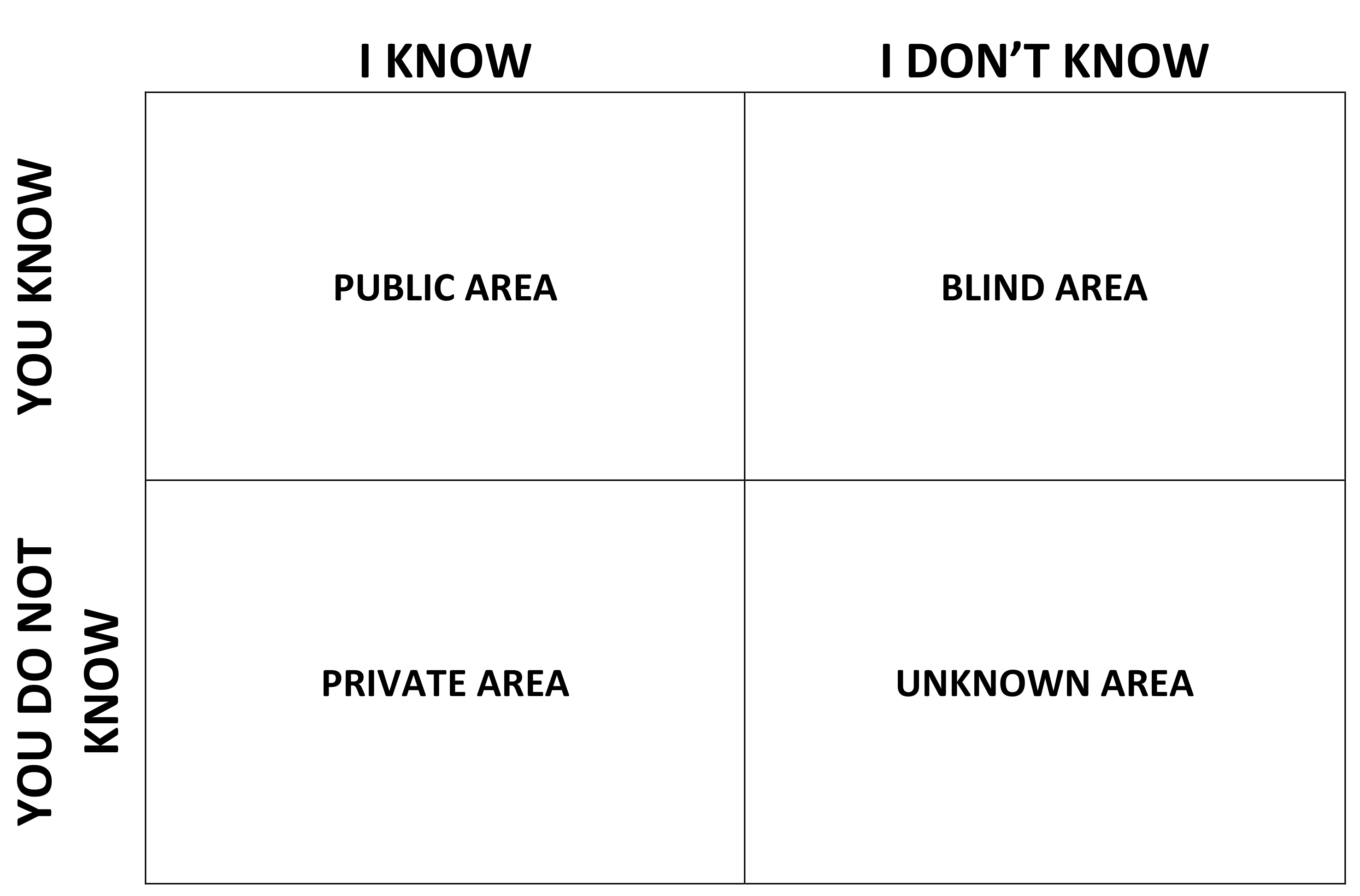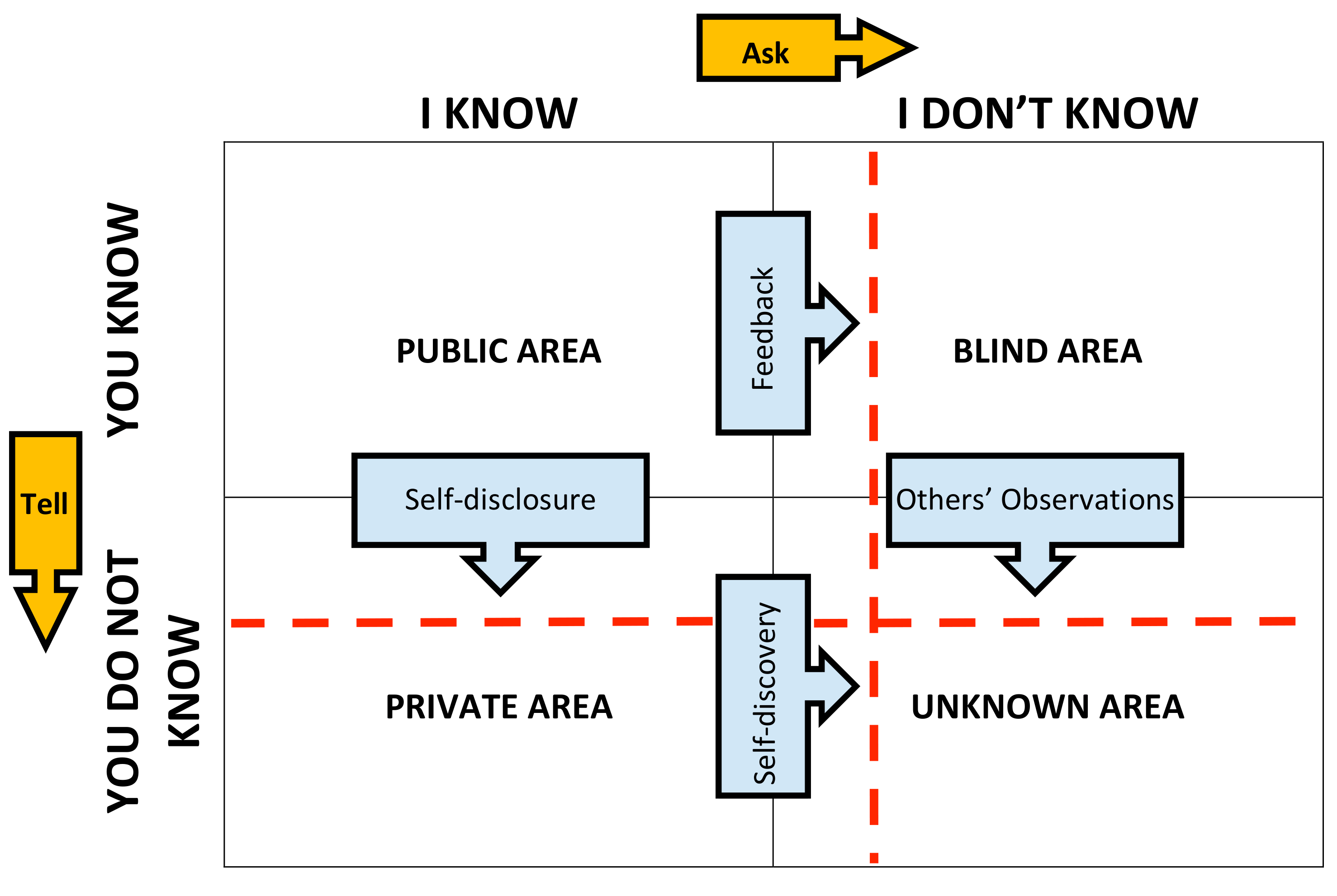Johari Window
An Introduction to the Johari Window
During the 1955 two psychologists, Joseph Luft and Harry Ingham, developed a simple tool to help people grow personally and professionally through gaining greater self-awareness of their relationship with themselves and others. They named it the Johari Window.
The Johari Window is a useful tool for understanding and enhancing your soft skills such as self-awareness, communication, interpersonal relationships, empathy, co-operation and interpersonal development.
The Original Johari Window
In the original exercise, induvial pick five adjectives from a list which they feel describes their own personality. The same list is given to their peers and they must pick a similar number of adjectives. The adjectives are then inserted into a grid with the following headers:
- Public Area
- Adjectives that both the subject and peers select.
- Blind Area
- Adjectives selected by peers, but not by the subject.
- Private Area
- Adjectives selected by the subject, but not by the peers. These are either things the peer are unaware of, or are untrue but for the subjects claim.
- Unknown Area
- Adjectives that neither subject nor peer select. These are behaviours or motives that no one recognises (either because they don’t apply or because of collective ignorance).
List of Adjectives
- able
- accepting
- adaptable
- bold
- brave
- calm
- caring
- cheerful
- clever
- complex
- confident
- dependable
- dignified
- empathetic
- energetic
- extroverted
- friendly
- giving
- happy
- helpful
- idealistic
- independent
- ingenious
- intelligent
- introverted
- kind
- knowledgeable
- logical
- loving
- mature
- modest
- nervous
- observant
- organized
- patient
- powerful
- proud
- quiet
- reflective
- relaxed
- religious
- responsive
- searching
- self-assertive
- self-conscious
- sensible
- sentimental
- shy
- silly
- smart
- spontaneous
- sympathetic
- tense
- trustworthy
- warm
- wise
- witty
The Johari Window in Practice
The Johari window does not have to be used only in this way. Let’s first understand what is going on. There are two factors at work within the Johari Window. First, what you know about yourself. Second, what others know about you. We can divide the four areas into quadrants (makes it look like a window!) and within each quadrant we can begin placing observations. These observations need not be limited to a list of adjectives describing your personality. Instead try to think about your strengths and weaknesses. Use the window to organise the feedback you generate and place it into the areas described below.

Areas of the Johari Window
Public Area
This is anything you know about yourself and that is known by others (or you are happy to share with others). It is usually uncontroversial information.
Blind Area
This is information that you may not know about yourself, but others do know because they experience it. If the first time you hear something in this area and it is a surprise, it is from your blind area.
Private Area
This is information known to you but not known by others (or you don’t want to share). It is not something you usually talk to others about.
Unknown Area
This is unknown to you and unknown to others.
Growing with the Johari Window
When you review your window, you can adjust the size of each quadrant to emphasise their relative contributions. However, this is not a fixed ratio and you can change the balance of the four quadrants. Once you’ve completed the first part of the exercise, take a moment to reflect on your findings.
The next step is to alter the ratio of your quadrants as you seek to increase the size of your public area. This will result in the shrinking of the remaining three areas. You can do this with three simple methods.
- Feedback
- Use feedback from others to become more aware of your positive and negative traits (as perceived by others). This can be uncomfortable to hear, but it is a positive step toward developing your skills. This will shrink your blind area.
- Self-Disclosure
- Build trust between yourself and others as you disclose information to them while learning more about them from the information they choose to disclose. This will shrink your private area.
- Self-Discovery and using Others’ Observations
- Spend time exploring your working habits as you work with others. Note what you are able to do and how you are managing to work together. Share information and receive feedback they give. It is possible to discover aspects that neither of you have appreciated before. This will shrink your unknown area.

Weaknesses of the Johari Window
No tool is perfect. On occasion, you may discover there are some things that are better not communicated with others. Sadly, you may find information is shared wider than anticipated and it may even be used in a negative way. Furthermore, some individuals or cultures do not respond well to personal feedback. For this reason, take care when using the model and ensure that everyone understands the true purpose for its use.